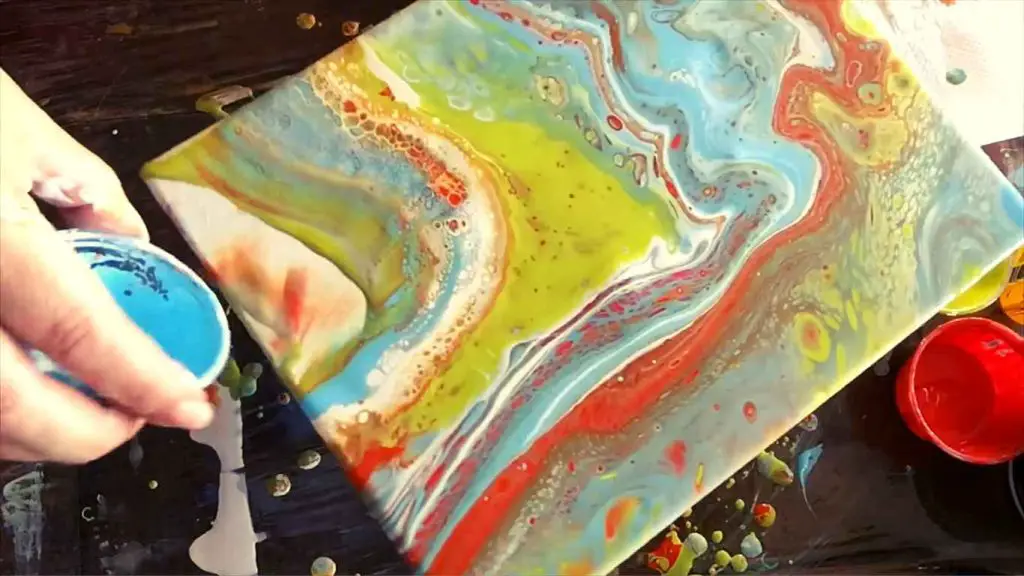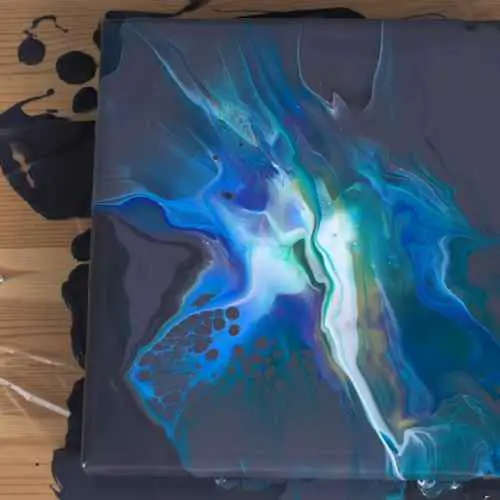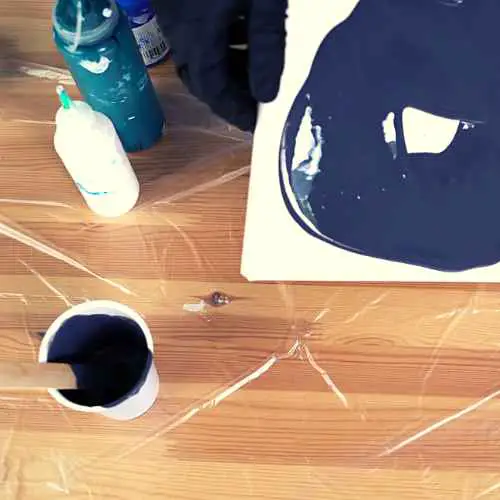Suppose you have some leftovers from your emulsion-based paint and decide to do paint pouring. But you may wonder, can you use emulsion for paint pouring?
Before going down deep, the simple answer is -Yes! But you must ensure you have house paint with emulsion, which may not work with regular paint.
Emulsion paint is water-based with various nonvolatile chemicals, such as acrylic resins. It is a type of water-based paint that contains a dispersion of tiny pigment particles in water. Emulsion paint is typically used for walls and ceilings, giving a smooth, even finish.
On the other hand, water is used as a solvent in acrylic paint, which is primarily used for pouring! So, it’s possible to use emulsion house paint for pouring.

Using Emulsion for Paint Pouring
Pour painting is abstract art where you pour different paint colors onto a canvas to create a unique design. It’s similar to splatter painting but with more control.
To do pour painting with emulsion paint, you’ll need to thin it out first. Otherwise, the color will be too thick and not flow evenly over the canvas. To thin out emulsion paint for pour painting, mix it with equal water, and then add a pouring medium to the mixture.
As you know, most emulsion paints need to be watery enough to be used as acrylic pouring. Mixing the pouring medium with paint would be best to create the color layers. Pouring mediums are substances that help the paint flow better and prevent it from drying out too quickly.
For your pillow, you can use any pouring medium, and you can use Floetrol as a pouring medium. Varnish is also a good option, and so is water. However, it would be best if you used 10% water of the weight.
You can buy pouring mediums online or at some art supply stores. Once you’ve mixed everything together, your emulsion paint should be ready to pour!
Emulsion Paint Pouring Art
If you’re looking for a fun and easy art project to try at home, look no further than emulsion paint pouring! This type of painting is perfect for beginners because it doesn’t require any special skills or techniques. Plus, it’s a great way to use leftover paint from previous projects.
To get started, you’ll need some supplies:
- Emulsion paint (water-based).
- A pouring medium (clear glue, liquid dish soap, Floetrol, or varnish).
- Cups or bottles for mixing.
- Something to pour the paint onto (like kitchen countertops, cardboard, or an old sheet).
Once your supplies are gathered, mix 1 part paint with 1 part pouring medium in a cup or bottle. Stir well to combine.
Now it’s time to start pouring! Begin by tilting your surface so one corner is higher than the rest. Pour your mixed paint onto this highest point, then watch as it cascades down the surface in beautiful swirls and patterns.
Experiment with different colors and amounts of paint to create different effects. When you’re finished painting, let your artwork dry completely before moving on to the next step. Once your painting is dry, it’s time to add some finishing touches!
You can use acrylic glazes or varnishes to give your artwork extra shine and durability. Or try adding some embellishments like glitter or beads for extra sparkle. Whatever you decide to do, have fun with it and let your creativity flow!

Mixing House Paint with Acrylic Paint?
Suppose you’re wondering if you can mix house paint, whether emulsion or not, with acrylic paint, the answer is yes! However, there are a few things to remember when doing so. First, it’s essential to know that not all house paints are created equal.
Some contain latex, while others use oil-based formulas. For the best results, mixing your acrylic paint with house paint with the same base (either emulsion or oil) is always best. Second, when combining these two types of stains, be sure to do so in a well-ventilated area, as both fumes can be intense.
Third, the ratio of house paint to acrylic paint will vary depending on the project you’re working on. A good rule of thumb is to start with a 1:1 ratio and adjust as needed.

Fourth, the fifth and final rule is to have fun!
Experiment with different ratios and colors until you find something you love. There’s no wrong way to do it!
Advantages
Acrylic paint mostly comes in a tube, and tube paints cost a lot! Whether emulsion house paint is cheaper and can also be used for pouring!
If you want higher performance and durability, then emulsion could be a great choice. Moreover, it dries a lot faster. You can wash this paint with soap and water easily.
Disadvantages
You should know a few things if you’re thinking about using emulsion wall paint instead of acrylic paint. Emulsion paint is not as opaque as acrylic paint, so your colors may not be as vibrant. Wall paints have a different consistency than acrylics, so they may behave in a different way when applied to your surface.
With all that said, if you’re still set on using wall paint for your project, be sure to do some test swatches first to see how it will work out!
Final Thoughts
Emulsion paint is a popular choice for paint pouring because it is easy to work with and produces beautiful results. When mixed with water, emulsion paint creates a thin, pourable mixture that flows readily and evenly over surfaces. The paint dries quickly, so you can see your results almost immediately.
If you are a beginner learning paint pouring, I suggest you try pouring with emulsion paint. It’s fun, cheap, and gives almost the same results as acrylic paints.

S. Pushon is a paint expert, self-taught artist, and currently working as an adviser in the paint industry as a Quality Improvement and Development Assistant.
An artist by heart, he draws remarkable art pieces and as a professional paint industry individual, he seeks the insight and shares with enthusiasts. Read more…
